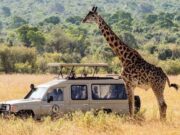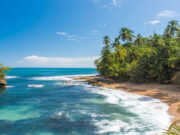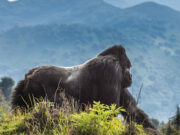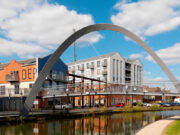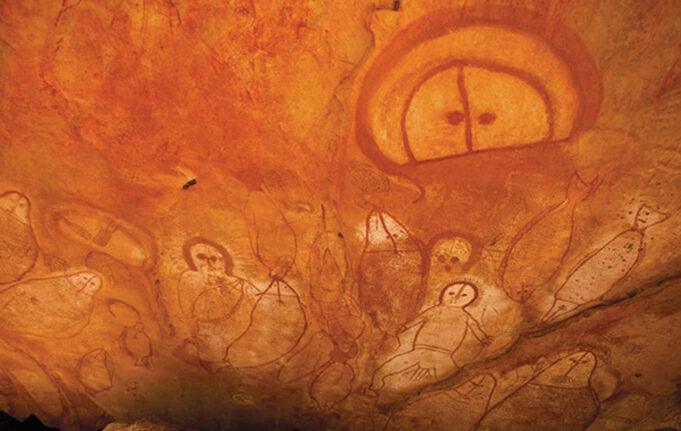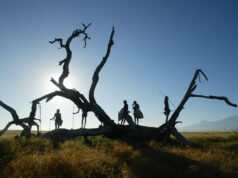Amy Watkins explores the stark and rugged Kimberley in northwest Australia in search of prehistoric creatures, ancient rock art and towering waterfalls
A trail of dinosaur footprints stood out against the red earth. I was at Gantheaume Point in northwestern Australia’s Kimberley region. Out there it’s easy to imagine a live T-Rex wandering around the dramatic sandstone in an area that is three times the size of the UK and is home to geography that dates back 250 million years. Populated by spiky spinifex grass and chubby boab ‘upside down’ trees, the violent landscape – pocked by awe-inspiring sandstone formations that have been squeezed out of the red earth over millions of years – is a stark reminder of the power of nature.
Evidence of ancient peoples is etched on to cave walls and aboriginal art sites are a highlight of the rugged region. Relatives of dinosaurs – prehistoric-looking crocodiles – lounge on mangrove riverbanks, while eagles and fruit bats fly overhead.
The Kimberley is the outback of popular imagination and can be explored by 4WD along the rough Gibb River Road that links Darwin to Broome. Doing it by expedition ship is another way to discover the remote corners of the Kimberley and I sailed with Orion, a luxury Australian expedition line. Our voyage began in Darwin, the tropical capital of Australia’s Northwest Territory.
GETTING AIRBORNE
Life is relaxed in the Top End and the city is a pleasant modern mix of restaurants and outlets offering croc-spotting tours. We headed west towards the old pearling centre of Broome and our first stop of Wyndham – where we berthed at the rickety pier. This is the oldest town in the Kimberley region, where gold was discovered in 1885 among the mangroves and mudflats.
It’s challenging to visualise the sheer scale of the Kimberley, but getting airborne is a good way to explore the vast landscape. Purnululu National Park, to give the Bungle Bungles their original Kija Aboriginal name, is famous for sandstone karst domes that emerge from the desert like gigantic beehives. The surreal orange and black ringed cones are surrounded by vast escarpments and dry riverbeds that cut through the earth like lightning bolts. We flew over Carlton Hill Station, a desolate plateau where Baz Lurhmann filmed much of his movie, Australia, and circled over ridges of earth that were pushed up like an angry crocodile’s spine. There were plenty of opportunities to see real crocodiles later in our 10-night journey, either among the mangroves of Hunter River or sunning themselves on rocky outcrops as we made our way to King George River Falls. Saltwater crocs lazed by the river and rock wallabies sheltered from the hot sun in the cracks in the sandstone. We made our way on inflatable Zodiac craft through the impressive gorge to the Twin Falls. The sun was beating down and a scramble up the side of the 80m falls was rewarded with a dip in a pool. Back down in the gorge, we were given another cool down when our drivers took us through the gushing waterfalls, deafening us with the thunder of nature raining down on our heads.
Later in the trip, we witnessed another incredible display of hydropower at Talbot Bay, where fast-moving tides surged through a gap in two sets of rock and created a ‘horizontal waterfall’. The Kimberley has some of the highest tidal ranges in the world, with spring tides of up to 12m, and this natural phenomenon is a swirling, violent reminder that nature is boss out here.
ANCIENT ART GALLERY
These extreme tides also cause a fascinating sight at Montgomery Reef, where tidal changes caused the reef to suddenly appear out of the water and created cascading waterfalls. As we waited in the Zodiacs, the reef appeared to rise up around us, revealing small sharks, manta rays and green turtles that appeared as if by magic.
Montgomery Reef was once the hunting ground of the native Worrora people. Our Zodiacs took us to a shell-strewn beach overlooked by curious-looking boab trees, where we disembarked and climbed to a cave surrounded by Kimberley Rose trees and swooping Brahaminy kites.
Inside the open-sided cave was an ancient art gallery. The Worrora used white ochre to paint fish, animals and Wandjinas (ancestral beings with haloed heads representing rain clouds) and when moisture gets into the sandstone it creates an eerie glow.
Ancient rock art is a highlight of the area. Jar Island, named after the fragments of pottery that were left behind by Macassans who came to collect sea-cucumbers in the 18th century, is home to possibly the world’s oldest figure paintings. Aboriginal people believed Gwion gwion (bird) art was created when birds pecked the rocks until they bled. The painted human figures have been named ‘Bradshaw’ art after the first European who recorded them in 1891 – a wasps’ nest covering one was carbon-dated to be more than 17,000 years old.
Towards the end of our journey to Broome, where old pearl luggers and historic tales awaited us, we stopped at the northernmost point of the Kimberley. As I scanned the pristine beach buffered by red cliffs at Cape Leveque, my footprints were the only mark on the pure sand. Dramatic and remote, the unforgettable Kimberley had given me the chance to walk in the footsteps of the dinosaurs and catch a glimpse of an ancient world, unspoiled by humans and time.



